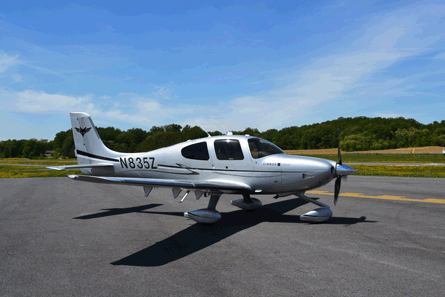Pilots of Cirrus aircraft equipped with Garmin's electronic stability and protection (ESP) system and other new speed-related safety aids should be virtually immune to a variety of loss-of-control accidents with the software protections.
Starting late last year, the airframer began offering the tools as part of a software upgrade on its Garmin G1000-based Perspective cockpit. Hawker Beechcraft also offers ESP as a retrofit package for its Garmin G1000-based King Air 200 cockpit.
Flight International sampled the safety offerings in a Cirrus SR22T (N835Z) on 10 May on a flight with Cirrus Mid-Atlantic sales director Boni Caldeira from Annapolis Lee airport in Edgewater, Maryland. From a hardware perspective, the tools do not affect the exterior of the piston-single, requiring only software and the stronger autopilot actuators that Cirrus began installing as forward fits in all SR20 and SR22 models last year. The King Air system works by the same principles, although the software thresholds for speeds will vary.
 |
|---|
© John Croft/Flightglobal |
The ESP system is designed to help the pilot maintain control within a reasonable flight envelope during hand-flying operations, when distractions or task saturation can cause loss of situational awareness followed by loss of control. Related aids, including underspeed and overspeed protection, operate with the autopilot turned on and will keep the aircraft flying at a safe speed. The industry will likely be keeping a close eye on the safety record for equipped aircraft going forward to determine if similar systems could help prevent loss-of-control accidents (precipitated by stalls and spins, overspeeds, steep spirals, etc.) in a larger swath of the sector, particularly for higher-performance business jets or even airliners.
Before departing the airport to the east in visual flight rules weather, Caldeira pointed out that the ESP was enabled, but noted that the system can be disabled for training purposes through on-screen menus or by pushing and holding the autopilot disconnect on the Cirrus's sidestick controller.
The system is automatically inhibited below 200ft (61m) above ground level in case a pilot needs to a perform relatively drastic manoeuvre for safety. Above 200ft, I could tell ESP was active by the double-white bars marking the 45° bank indicators on the primary flight display attitude indicator. There is no complementary indication on the pitch bar.
Once in flight with the autopilot off, Caldeira allowed the Cirrus to naturally enter a left-hand nose-low spiral, aided by left rudder input, an aircraft instability historically called the "graveyard spiral". Once the bank angle exceeded 45°, the ESP began back-driving the sidestick with a force of roughly 2.3kg (5lb), increasing linearly if the pilot overpowers the torque and continues to bank more steeply.
 |
|---|
From the pilot's perspective, the ESP kickback is brisk and authoritative, alerting you instantly that there is an attitude issue. The corrective force decreases to zero at 30° bank. In another demonstration, Caldeira simulated a runaway roll trim failure to the right, which resulted in the aircraft fairly rapidly cycling between 30° and 45° of right bank, not an ideal condition but a safe state from which the pilot would have time to analyse the failure.
Pitch demonstrations were similarly effective, with a restorative nose-down force of as much as 4.5kg delivered swiftly to the sidestick when Caldeira pitched the SR22's nose above a pitch angle of about 17°. Restorative forces abated to zero force once the nose descended below about 12°. Similarly, in the nose-low case, ESP began back-driving the sidestick with about 4.5kg of force starting at roughly 15° nose-low and decreasing to zero when about 10° below the horizon.
ESP's high airspeed protection uses a pitch-up force on the sidestick to alert the pilot to the situation and to begin slowing the aircraft down. Caldeira was not able to demonstrate this case, but explained that the restorative force when flying below 17,500ft kicks in at 200kt (370km/h) and drops to zero when the aircraft slows to 190kt.
With the autopilot on, Caldeira demonstrated how low-speed protect will keep the aircraft from stalling in situations in which the pilot reduces power to descend to a commanded final altitude but forgets to add power back in when the altitude is reached. Underspeed protection will automatically kick in when the airspeed decays to within 3-5kt of stall speed, reducing pitch angle to maintain that while allowing altitude to decrease. Along with the audible stall warning, Perspective makes an "airspeed" announcement. Once Caldeira added power back in, the SR22 aggressively climbed back to the target altitude of 3,000ft at the same safe minimum airspeed.
On the other end of the speed spectrum, the autopilot's overspeed protect limited airspeed to 185kt as Caldeira dived the Cirrus at a 2,500ft/min (12.7m/s) descent rate. By reducing the downward pitch, the autopilot maintained a 1,500ft/min descent at that speed.
Source: Flight International
















